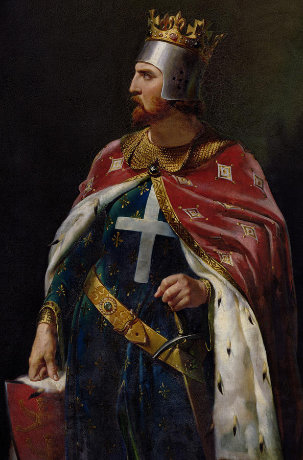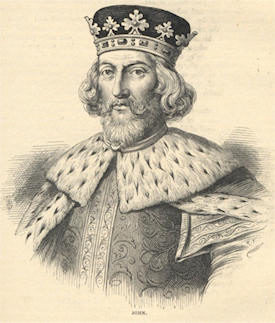Richard I
Richard I (king from 1189-1199) was a very brave fighter and had earned the nickname Cœur de Lion (the Lionheart) even before he became king. Unfortunately all that bravery in battle came at a cost: Richard spent less than a year of his 10-year reign as King of England actually in England! Some say that England was sadly neglected in his absence.

Dates:
- Born 1157
- Ruled from 1189
- Died 1199
Who was he?
What is he most remembered for?
- Being a brave warrior and strong leader, hence the nickname Richard the Lionheart.
- Spending less than a year of his 10-year reign in England.
- Fighting in the Third Crusade.
- Being kidnapped by the Duke of Austria.
- Dying from a crossbow injury, which became infected.
What happened next?
When Richard died in 1199, aged 41, he had no children and had named his younger brother (King John) as heir.
Points of interest
Richard was buried at the foot of his father’s grave in Fontevrault Abbey, but he is also found all over France. His heart is in Rouen Cathedral, his brain is said to be in Charroux Abbey and he asked for his guts to be buried in Chalus where he died!
Mnemonic
Richard, the King with the Lion’s Heart,
Decided quite early to depart
To fight the Muslims and conquer them,
And so retake Jerusalem.
[source: https://antoniaharrison.blogspot.com/2011/02/rhyme-to-remember-english-monarchs.html]
A Short Biography of Richard I
The third-born son of Henry II, Richard was the oldest surviving son when his father died. He was born at Beaumont Palace near Oxford but spent most of his childhood with his mother, Eleanor, in Aquitaine, France.
Richard loved a good battle, and soon after he was crowned king, he went to fight in the Third Crusade (a religious war between Christians and Muslims). There he joined his rival King Philip II of France and Germany’s Holy Roman Emperor Frederick Barbarossa. The Pope had ordered Christian armies to fight against Muslims in Palestine, because they believed Jerusalem was rightfully theirs. Richard helped to defeat Saladin, the first ruler of Egypt, but failed to capture Jerusalem. Barbarossa had drowned along the way and Philip made an earlier return to France.
While Richard was out of the country, there were issues about who should govern in his absence: his younger brother John; his illegitimate half-brother Geoffrey; or his nephew Arthur (son of his deceased older brother Geoffrey). Richard didn’t want to give any control to John or Geoffrey in case they tried to take the throne. He therefore made Geoffrey Archbishop of York (because no cleric could be king) and banished John from England for three years. Instead, he left William Longchamps, an old and trusted friend, in charge.
On his return home from the Crusade in 1192, Richard was kidnapped by the Duke of Austria. He was later handed over to the German Emperor Henry VI and imprisoned. Having heard nothing of his brother for months, and believing that Richard was dead, John plotted to take the throne. He sought the support of King Philip of France as well as support at home.
English nobles paid a huge ransom to get Richard back in 1194, but no sooner had he returned to England to get some more finances together, that he travelled back to France! Richard’s last five years were spent contesting with King Philip of France over various pieces of land. He died trying to capture Chalus Castle, Limousin, when a crossbow injury to his shoulder became infected.
Richard had married a princess, Berengaria, in 1191, but, because he was away so much, the couple hardly saw each other and had no children. On his deathbed, Richard forgave John for trying to claim the throne and named him his heir.
Our Richard II Printables
Richard I Fact Sheet
Download and print our interesting facts and short biography of Richard I, more commonly known as Richard the Lionheart - a warlike king!
Richard the Lionheart Colouring Page
Here's an etching-style colouring page of Richard the Lionheart in all his glory ready to fight on one of the Crusades.
Richard the Lionheart Portrait
This portrait of Richard the Lionheart - Richard I of England - dates to the mid-19th century, so we don't know how true to life it is. But it certainly makes the king look brave!






